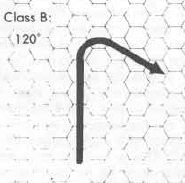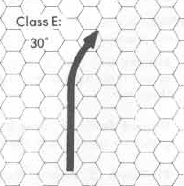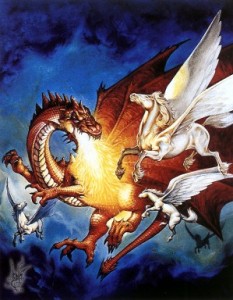|
|
|
|
|
|
|
|
|
|
|
|
|
|
|
|
|
|
Most creatures which can fly do so by means
of wings,
either natural or magically augmented
(as in such inherently magical beings
as demons && devils,
dragons,
griffons,
etc.).
Most winged creatures must be constantly
flapping their wings to provide enough thrust to keep their weight in the
air.
Some creatures are light enough and powerful
enough to allow them to actually hover in one place,
but most must be constantly moving forward.
This means that aerial combat is nearly
always going to be a swoop and slash,
hit-and-run affair.
Grappling of opponents in the air will
generally result in both of them plummeting to the ground,
unless they are at a high altitude and
disengage almost immediately.
Even then, it is a risky business.
Only beings with the ability to hover
(gained either through quick and powerful wings or some form of magical
flight)
will be able to engage in combat that
resembles the round-after-round melee system employed in ground battle.
It will therefore be seen that maneuverability
is of prime importance in conducting aerial combat.
Flying combatants -- whether they are
eagles or dragons, men mounted on broomsticks, or hippogriffs --
must make attack passes at their opponents,
wheel about in the air, and attack
again. Those which are more maneuverable
will be able to change
direction and speed in a shorter time
than those which are less maneuverable,
and thus have some advantage in pursuit
and avoidance.
To conduct an aerial battle, a DM must
know the SPEED, maneuverability
and attack modes
of each creature involved.
A ranger and his griffonmount face
off
against wyverns high in the air.
SPEED of flight of each creature is listed
with the other information in the AD&DMM,
and it will be noted again in the list
of aerial creatures at the end of this section.
When conducting aerial combat that takes
place entirely in the air,
it will be convenient to convert inches
per turn to inches (or hexes) per round.
For the sake of standardization,
They will be able to climb one foot for
every three feet they move forward,
but they may dive up to one foot downward
for each foot travelled forward
(i.e., at a 45-degree angle.
None of the above applies to creatures
with class A maneuverability,
which can move in any direction they choose.).
When diving, all creatures' physical attacks
will do double damage to all targets which are not themselves diving.
This includes diving attacks at earthbound
creatures which come from a height of 30 feet or more.
There is no damage penalty for attack
while climbing.
No creature will be able to climb above
5000 feet (due to lack of breathable air) as a general rule,
but you may alter the ceiling if you wish.

Naturally, every type of flying creature
maneuvers differently from every other type,
but in order to make the game playable
and aerial combat
possible, maneuverability has been broken
down into five classes.
These vary from A to E, most maneuverable
to least maneuverable.
Note that the stated amount the creature
can turn per round assumes that the creature is moving at full speed.
Creatures moving at half speed turn as
one class better.
Winged creatures cannot move at less than
one-half speed and remain airborne (except for class B).

Creature can turn 180° per round, and
requires 1 segment to
reach full airspeed. Creature requires
1 segment to come to a full stop in
the air, and can hover in place. Class
A creatures have total and almost
instontoneous control of their movements
in the air. Examples: djinn,
air
elementals,
aerial servants, couatl.

Creature can turn 120° per round, and
requires 6 segments to
reach full airspeed. Creature requires
5 segments to come to a full stop in
the air, and can hover in place. Examples:
fly
spell, sprites, sylphs, giant
wasps, ki-rin.

Creature can turn 90° per round, and
requires 1 round to reach
full airspeed. Examples: carpet or wings
of flying, gargoyles, harpies,
pegasi, lammasu, shedu.

Creature can turn 60° per round, and
requires 2 rounds to reach
full airspeed. Examples: pteranodons,
sphinxes,
mounted pegasi.

Creature can turn 30° per round, and
requires 4 rounds to reach full airspeed.
Examples: dragons,
rocs, wyverns.

Attack Modes:
As mentioned previously, grappling in
the air is usually out of the question.
This means that many different creatures
will use considerably
different combat tactics in the air, and
their "natural" methods of attack
will often be substantially altered.
The following list should help the DM
determine how certain creatures will fight in the air.
SPEED && maneuverability class
are also listed.
For reasons of space or redundancy,
not all flying creatures have been included.
Once familiar with the system,
the DM should be able to apply it to any
aerial monster.

Conducting aerial combat will be much simplified
if the DM will
remember that most flying monsters simply
cannot execute complicated
maneuvers like barrel rolls or loop-the-loops.
Most can do nothing more
than climb, dive and/or turn, and all
of these actions are easily simulated
and quantified using speed and maneuverability
classes.
There are two methods you can use to conduct
aerial combat. The first
way is simple but less accurate. The second
method is more accurate but
requires the use of hex paper or a hex
map. Though both can be done on
paper, the best way to visualize the relative
positions of the combatants
is to employ miniature figures or paper
counters. A running record of
absolute (or relative) altitude should
be kept, either on a separate sheet
or on a small piece of paper under each
figure or counter.
The simple method
is to move each flyer in the direction they are facing
at the beginning of the move, and execute
the turn at the end by simply
refacing the flyer in its new direction.
Speed would be in actual inches of
movement, or some ratio thereof.

A more accurate method
entails the use of hex paper so that actual arc
turns can be indicated, and so that these
turns may take place at any
time during a move.

Turns will actually take place through
several hexes (the only exceptions
to this are creatures from the elemental
plane of air, which can turn on a
dime in any direction they wish). A turn
need not be executed through
consecutive hexes. To illustrate, here
are possible variant turns for a class B
flyer, which can turn up to 120° in
one round:

The orders for the first example would read: Straight 1, right 60°, straight 3, right 60°, straight 1 .
Each flyer can move 1 hex per 3" of speed;
thus, a gargoyle,
with a speed of 15", could move 5 hexes,
while a griffon, with a speed of 30",
could move 10.
Keep in mind climbing and diving speed
alterations.
In both the
simple and complex methods, movement should be simultaneous.
If there are several players involved,
you may wish to have
them write out their moves ahead of time
(the DM, of course, is not obligated
to do this). If two opponents are clearly
making for each other, and
it is within their ability to intercept
but their written orders would cause
them to miss, some slight adjustment should
be made.
Aerial Missile Fire:
For all missiles fired in the air,
treat short range as medium (-2 to hit)
and medium range as long (-5 to hit) as pertains to chance of hitting.
Fire at objects at long range will always
miss.
The above applies to missile firers on
flying mounts or using a broom or wings of flying only if they have spent
several months in practice.
Otherwise, they will not be able to hit
at all.
The range penalties also apply to missile-firing
creatures such as manticores (treat as composite long bow as pertains to
range).
Note that the above applies only to those
who are moving.
Those hovering with a fly spell or on
a carpet of flying will suffer no penalties.
Those levitating will be penalized as
delineated in earlier subsection Attack Modes, Men: Levitation.
Dragons and similar creatures with breath weapons (such as chimerae) will have a slightly harder time hitting other flying creatures. For this reason, moving aerial targets of flying dragons add +2 to their saving throws.
Any winged creature which sustains damage
greater than 50% of its hit points will be unable to maintain flight and
must land.
Any winged creature which sustains more
than 75% damage will not even be able to control its fall,
and will plummet to the ground.
This simulates damage to the wings,
as in aerial combat,
the wings will be a prime point of vulnerability.
Feathered
wings are not as easy to damage as membranous wings,
and in flight should
be given an extra HP value equal to one-half the normal
HP
of the creature they support,
for the purpose
of figuring how much damage need be taken before the creature can no longer
fly.
Thus, a griffon
with 30 hit points would add an additional illusory 15 points in aerial
combat,
for a flight-damage
total of 45, and thus would be able to take 23 points of damage before
it would be forced to land.
In contrast,
a membrane-winged
creature like a succubus with 30 hit points would only be able to sustain
15 points of damage before it could no longer fly.
Under no conditions are the extra flight-damage
points to be added to the monster's actual hit points for the purpose of
absorbing damage.
A flying monster will only be able to
sustain the normal amount of damage it usually takes in order to incapacitate
or kill it, i.e.,
if the exemplary griffon above takes 31
points of damage from dragon breath, it is dead.
As a final note,
remember that heroic aviators who leap
into the saddle of their hippogriff and rise to battle without taking a
couple of rounds to strap in will tend to fall out in the first round of
melee,
and it is 1-6 hit points of damage for
every ten feet they fall (up to a maximum 20-120 points).